#emperor penguin
Text
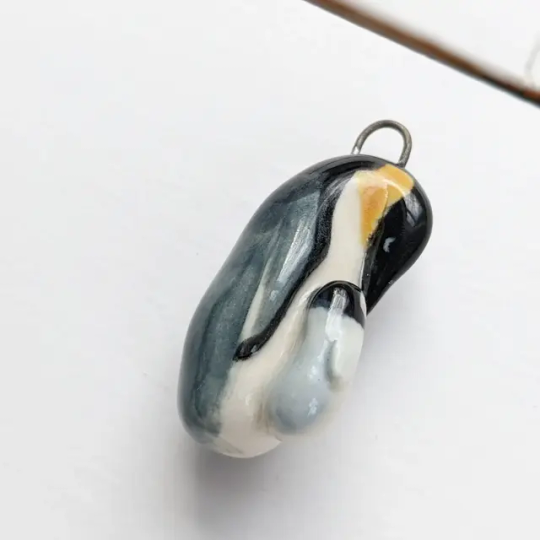

A penguin parent and chick.
This was a commissioned piece for a keychain, made last year.
#cute#ceramics#artoftheday#handmade#art#pottery#porcelain#porcelaine#penguins#penguin#emperor penguin#keychain#keyring
1K notes
·
View notes
Text
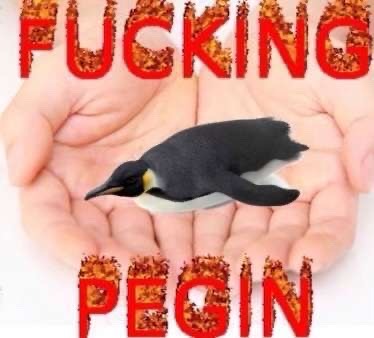
#emperor penguin#penguins#marine biology#marine birds#aquarium#ocean meme#oceanposting#marine biology memes#zoology#marine life#sea creatures#antarctica
4K notes
·
View notes
Text

Emperor penguins!! This is my favorite bird sketch I’ve done so far :,)
#my art#artists on tumblr#art#sketch book#colored pencil#penguins#animal art#bird art#birds#emperor penguin#traditional art
231 notes
·
View notes
Text

the classic emperor penguin for Marchirp day 5!
(Marchirp is run by @elliottnotyet)
202 notes
·
View notes
Text

C H I C K S . . .
2K notes
·
View notes
Text

Round
147 notes
·
View notes
Text
Emperor penguin dads in Antarctica! After mating, the female lays a single, large egg that is then transferred to the feet of the male, who will incubate the egg until it hatches.
The male proceeds to "sit on the egg", covering it with a blanket of feathers, skin, and fat for two months in the dead of winter. During this time, the male does not feed and huddles with other nearby males to conserve body heat.
323 notes
·
View notes
Photo
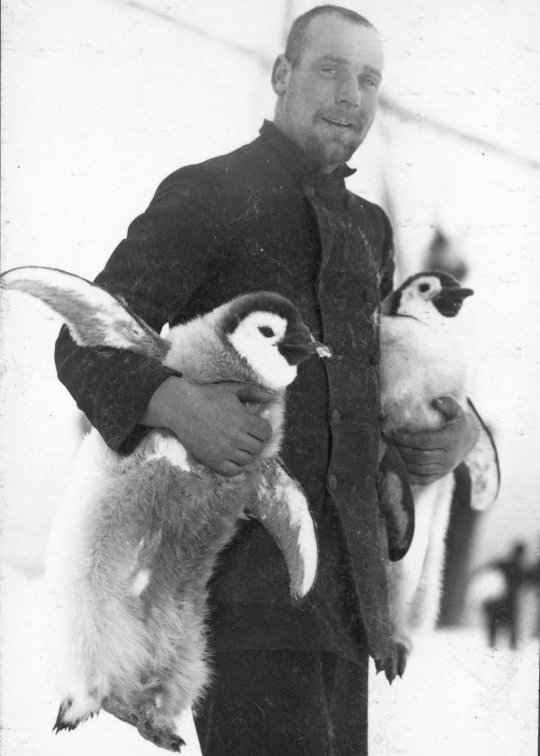
Navigating Officer Hubert Hudson with Emperor penguin chicks. Shackleton’s Expedition to Antarctica on The Endurance. 1914-1917
I Am Collective Memories • Follow me, — says Visual Ratatosk
#BW#Black and White#Preto e Branco#Noir et Blanc#黒と白#Schwarzweiß#retro#vintage#Hubert Hudson#Emperor penguin#Shackleton’s Expedition#Antarctica#Endurance#1914#1917#1910s#birds#oiseaux#Vögel#pássaros#日本語: 鳥#pájaros#ptaki#한국어: 새#廣東話: 鳥
79 notes
·
View notes
Text
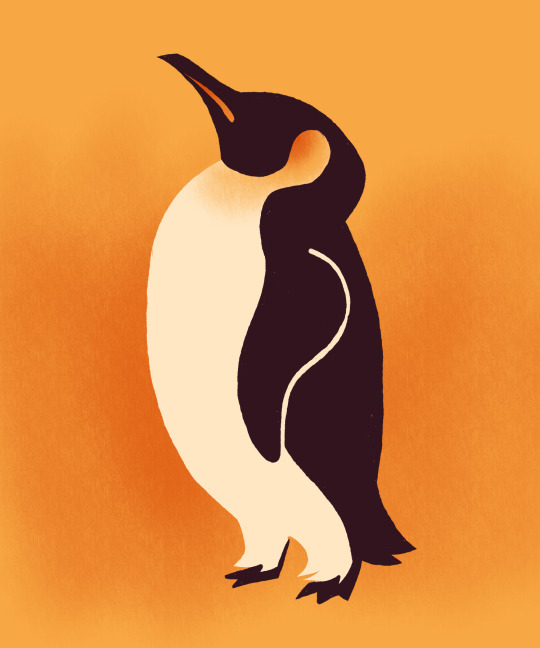
patron request for a penguin!
103 notes
·
View notes
Text

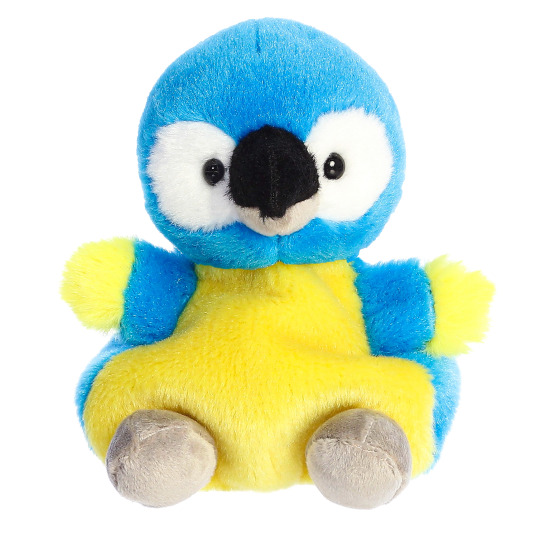

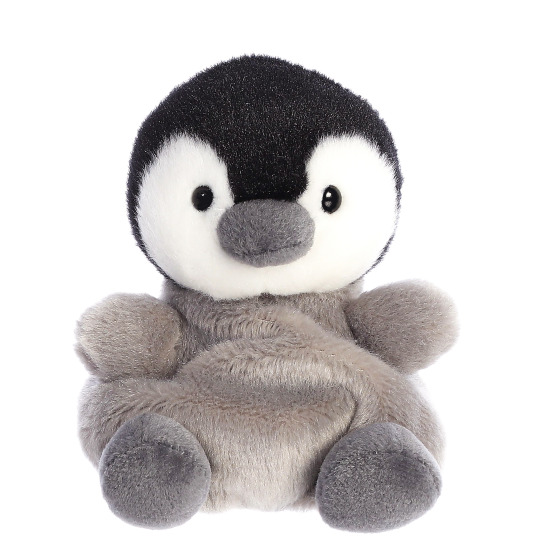
❤️ aurora palm pals birds ❤️
#bird#birds#macaw#scarlet macaw#blue and yellow macaw#flamingo#penguin#emperor penguin#parrot#parrots#parrot plush#plush#plushblr#plushie#plushies#aurora#palm pals#plushcore#birdblr#toycore#kidcore#best
1K notes
·
View notes
Text


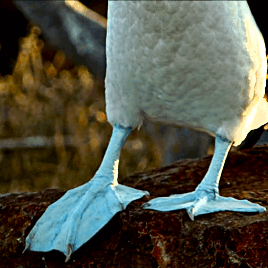

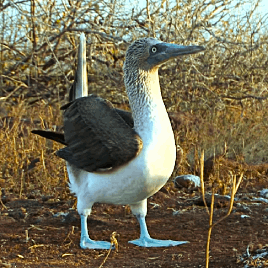


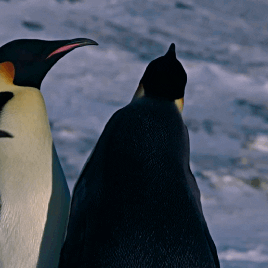

emperor penguins and blue-footed boobies for @mushyfrogcakes :•]
[ID: A 3x3 stimboard of 9 GIFs.
GIF 1: A blue-footed boobie, a medium-sized bird with blue feet, a white belly, dark brown wings and a light brown neck and head, gently lifting one foot then putting it down and shaking its head.
GIF 2: A closeup of an emperor penguin's head, a penguin with a black head and back, white belly, and yellow-orange feathers around the base of its head, shaking its head.
GIF 3: A closeup of a blue-footed boobie's feet as it gently lifts one foot up and down.
GIF 4: A view of an emperor penguin standing still, its breath visible and lit up by the sun as it exhales.
GIF 5 (center): A blue-footed boobie rapidly shaking its head up and down as a dance.
GIF 6: Two emperor penguins waddling around while one stands still.
GIF 7: A blue-footed boobie slowly sitting down on two eggs.
GIF 8: An emperor penguin quickly shaking its head back and forth.
GIF 9: A blue-footed boobie stretching it's wings out and forwards before relaxing.
End ID]
#scopostims original boards#scopo gifs#stim#stimblr#stimboard#stimmy#bird#birds#penguin#emperor penguin#blue footed booby#nature#animal
122 notes
·
View notes
Text
Animal of the Day!
Emperor Penguin (Aptenodytes forsteri)
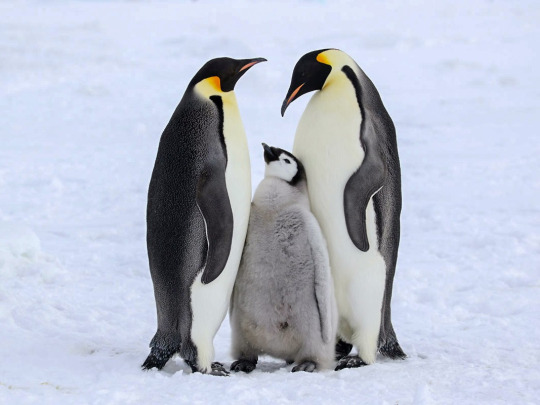
(Photo by Noah Strycker)
Conservation Status- Near Threatened
Habitat- Antarctica
Size (Weight/Length)- 40 kg; 120 cm tall
Diet- Fish; Krill; Squid
Cool Facts- The award for the best parents in the animal kingdom goes to the emperor penguin. During the dead of winter, emperor penguins waddle up to 120 kilometers away from the ocean to lay their singular egg. Thousands of penguins make up these mass breeding colonies, far from predators but also far from food. Temperatures fall to -40 Celsius and winds reach up to 144 kilometers per hour. Three centimeters of fat help to protect the penguins from the brutal weather and the combined body heat of penguin huddles can reach 37 Celsius in the center. Parents have to balance their egg on their feet, hidden from the chill by a flap of fat, due to the ground being lethal on contact for the unhatched baby. The other parent is forced to waddle back to the sea and swim up to 500 kilometers in search of enough food to feed themselves, their mate, and their chick upon hatching.
Rating- 13/10 (I’ve never wanted to hug an animal more.)
#animal of the day#animals#birds#penguin#friday#december 22#emperor penguin#biology#science#conservation#the more you know
116 notes
·
View notes
Text

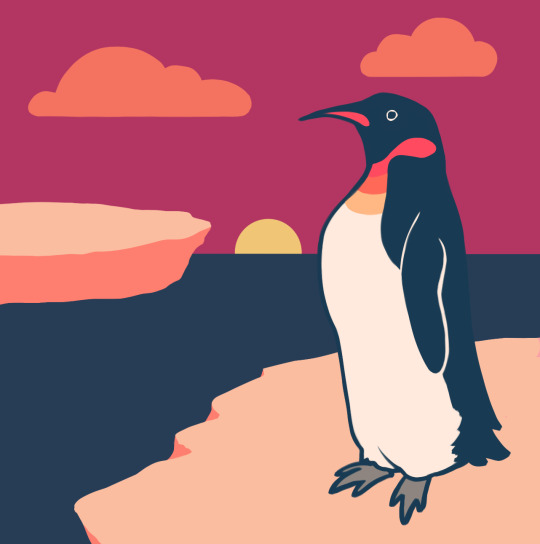
565 notes
·
View notes
Text
Wet Beast Wednesday: emperor penguin
This is the last Wet Beast Wednesday before Christmas and Christmas is associated with the north pole thanks to Santa. So to celebrate the season, I'm going about as far away from the north pole as it is possible to go and talking about the emperor penguin. This also happens to be the first dinosaur I've showcased on this series.
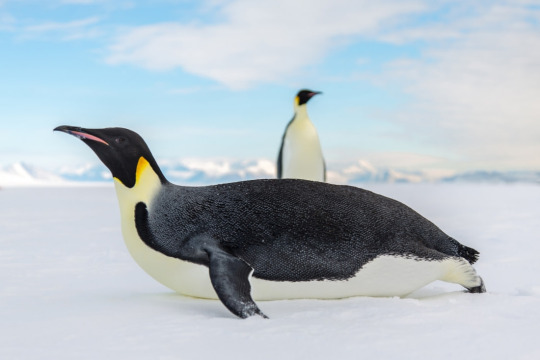
(image id: an emperor penguin lying belly-down on ice, seen from the side. Its back, wings, and head are black while its belly and neck are white. It has a patch of orange feathers near the ears. Another penguin is standing up in the background. end id)
Aptenodytes forsteri is the largest of all penguins and the sixth largest (by weight) bird in the world, only surpassed by the emu and two species each of the cassowary and ostrich. Those are all paleognaths, one of two living groups of birds, making the emperor penguin the largest of the other group: the neognaths. There are some discrepancies on their size due to the standards of bird measurement, but recent measurements list their standing height as reaching 120 cm (3.9 ft) with a weight of 22.7 to 45.4 kg (50 to 100 lbs). Their weight varies a lot during their lives, with both males and females losing a lot of weight during breeding season. Males generally weigh more than females. Genomic and anatomical analysis indicates that the emperor penguin, along with the closely-related king penguin and an extinct species, are part of a group of penguins that branched off of the family tree before the other living penguin species. As with other penguin species, they are heavily adapted for life in the water. All penguins are flightless, with their wings having adapted into flippers used for swimming. Penguins stand differently than other birds. Most birds have long legs and hold their bodies horizontally to the ground or at an angle, but penguins have short legs and hold their bodies vertically, like humans do. This, plus other adaptations, helps streamline the birds, letting them swim more efficiently. Like other seabirds, their feathers are very dense and coated with oil that repels water. This keeps the feathers from becoming waterlogged, reducing drag and helping keep the bird warm. During molting season, the feathers emerge from the skin mostly formed and push out the old feathers, preventing the penguin from developing bald or thin patched that would compromise insulation. While the feathers are responsible for most of the insulation, a layer of fat also helps. Like other birds, penguins are endothermic, commonly known as warm-blooded. Penguin tongues have backward-pointing barbs that help prevent food from escaping their mouths.

(image id: an emperor penguin jumping out of the water and onto ice. It is pictured in midair with its body roughly parallel to the ground and wings extended. Multiple other penguins are in the background. end id)
Emperor penguin's divide their year between the breeding season and the rest of their lives. During most of the year, they spend their time searching for food. Most of this food consists of fish, krill, and squid. Emperor penguins are social animals that often coordinate with each other to hunt in groups. While hunting, they will dive up to 535 meters (1,755 ft) and spend up to 21 minutes underwater before surfacing to breathe. During dives, the pressure can increase up to 40 times and the emperor penguin has some special adaptations to cope. Unlike most birds, emperor penguin bones are solid, reducing the chance of one breaking under pressure. During dives, the heartbeat slows dramatically and non-essential organs cease functioning to conserve oxygen in the blood. In addition, the hemoglobin in the red blood cells is modified to carry more oxygen in high pressure and low temperature. While on land, emperor penguins gather in colonies along the shoreline. Members of the colonies spend a lot of them time huddled against each other to keep warm. The penguins live all around Antarctica between 66 and 77 degrees southern latitude.
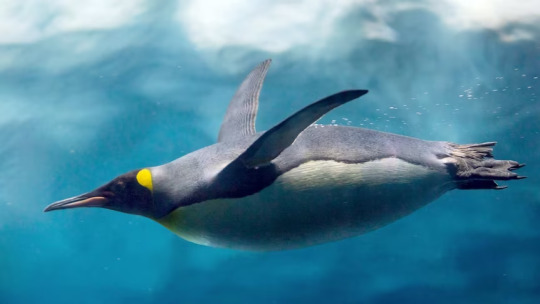
(image: an emperor penguin swimming underwater. Its head is pointed up, making its body very streamlines. Its wings are extended and are used for propulsion and steering. end id)
The thing emperor penguins are most famous for is their breeding behavior. Breeding season starts at the beginning of winter in Antarctica, between March and April, and is triggered by the decrease in day length. Penguin colonies travel inland en masse moving between 50 and 120 km (31 to 75 miles) to find a spot to raise their chicks. These spots are usually large, flat patches of sea or lake ice with a barrier such as a cliff or iceberg used to block the wind. Males perform sexual displays wherein they make loud courtship calls while wandering around the colony. When a female is interested, she will face they male and they will both hold their heads up for a few minutes. Once a pair os formed, they will walk around the colony together. When ready to mate, The pair will bow to each other. Emperor penguins are serially monogamous. They will only mate with one other penguin each season, but rarely pick the same mate more than once. The pair say together until the egg is laid in late May or early June. The female then transfers the egg (only one is laid every year) to the male, a tricky process. They have to use their feet to transfer the egg without dropping it. If the egg breaks or is exposed to the ice for more than a minute or so, it will die. It is not uncommon for an egg to be lost, especially in first-time parents. If this happens, both parents will leave the colony and return to the sea, not mating again until next year. The male balances the egg on his feet and covers it with a loose flap of skin. The bottom of this skin is a featherless patch called the brood patch that only forms during this season. By keeping the egg between his feet and the brood patch, the male incubates it. Once the egg is transferred, the female returns to the sea, leaving the male responsible for the next few months. In every other penguin species, the mother and father take turns incubating their egg. for the next 65-75 days, the male will incubate the egg in the middle of the Antarctic winter, where storms are frequent and temperatures can can reach into the -60s C (-70s F). He will not eat at all during this period, which, including travel and mating time, can last for 120 days. Males can lose up to half of their body mass during this fast. If the egg is dropped even once, it has a very high chance of dying. Walking without dropping the egg is tricky, but the males will form tight bunches to conserve body heat. These bunches are mobile, with members to the outside gradually moving inward and vice-versa. The egg usually hatches after around 60 days and it can take a few days to break out of its shell, which is thicker than in most bird species. The chicks are born featherless and will freeze to death if they leave the male's brood pouch. The male produces a substance called crop milk with a gland in his esophagus. Crop milk is unique to pigeons, flamingos, and male emperor penguins and is used to feed the chick. The crop milk does not provide full nourishment to the chick, but will keep it alive for about a week.
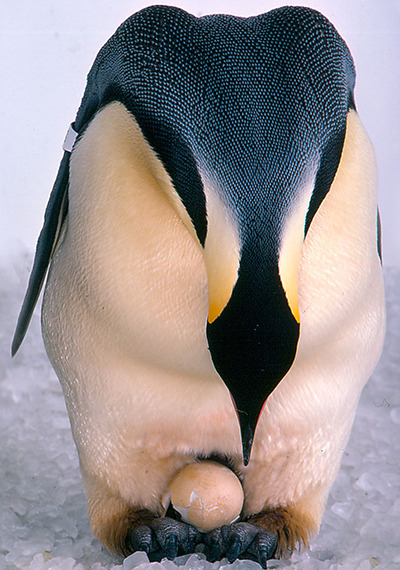
(image id: a male emperor penguin standing on ice with its egg balanced on its feet. The skin flap thet normally covers the egg is pulled back and the male is bending over to examine the egg. This egg is broken, possibly the result of being dropped, and is non-viable. end id)

(image id: a newly-hatched emperor penguin sitting on it's father's feet. It is very small and featherless, with grey skin and a black head. end id)
About this time, the female will return from her time at sea. She spent this time feeding and fattening herself up for the next leg of the parenting journey. She returns to the colony usually between 5 and 10 days after the hatching. If she arrives too late, the chick will starve. Once she arrives, she will locate her mate through the sound of his calls. The male then transfers the chick to the female's brood pouch and returns to the sea to feed and put weight on for another 3-4 weeks. The female will feed the chick by regurgitating half-digested food into its mouth. After this, the mother and father will take turns brooding the chick and feeding at sea. If either parent is delayed or dies, the chick will die as the remaining parent will eventually abandon it and return to sea. Orphaned chicks will try to seek food and shelter from other adults and mothers who have lost a chick may try to adopt an abandoned one, but as a single parent cannot raise a chick alone, it will eventually be abandoned as the adult goes to feed. Sometimes, a mother who lost her chick will attempt to steal a chick from another mother. This leads to fights over chicks that may leave chick trampled to death.
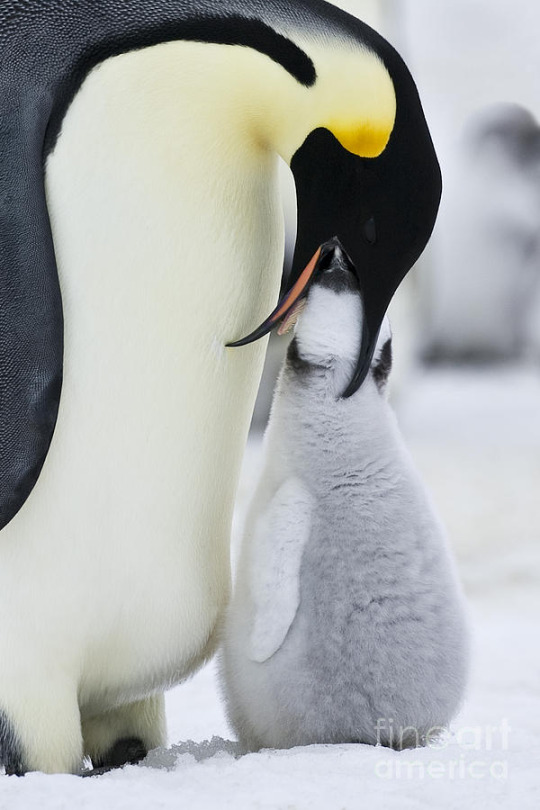
(image id: an adult emperor penguin feeding its chick. The chick is larger and covered in fluffy, grey, downy feathers. It no longer needs to stay on its parent's feet. The adult is looking down at the chick with its mouth open. The chick has its head inside the adult's mouth. end id)
Starting 45-50 days after hatching, the chicks now have a thick enough coat of down to survive outside of the brood pouch. Starting around this time, both parents will return to the sea and occasionally return to bring food, using the sound of their chick's vocalizations to track them down. When the parents are gone, the chick huddle together for warmth. Starting in early November, the chicks will start gaining their adult plumage and the adults will stop returning to feed them. Once they get hungry enough, the chicks will make the trip to the sea (which is shorter now as it is summer in the Antarctic and the sea ice has receded) and will be independent from now on. Only 15% of chicks survive their first year, but after that the survival rate is 95%, meaning most living emperor penguins are adults. Emperor penguins reach sexual maturity at 3 years, but most do not mate until they are 4-6 years old. The average lifespan of those who live long enough to reach adulthood is 20 years, but may live up to 50 years. The high survival rate of adults is in part due to a lack of predators. Adult emperor penguins are only hunted by leopard seals and orcas, though the former prefer juveniles. Juveniles are preyed upon by seals when they reach the water and by southern great petrels when on the ice. Adult emperor penguins lack any land predators, which has resulted in them having no prey response when on land. Scientists and antarctic explorers have reported that adults will approach them without fear.
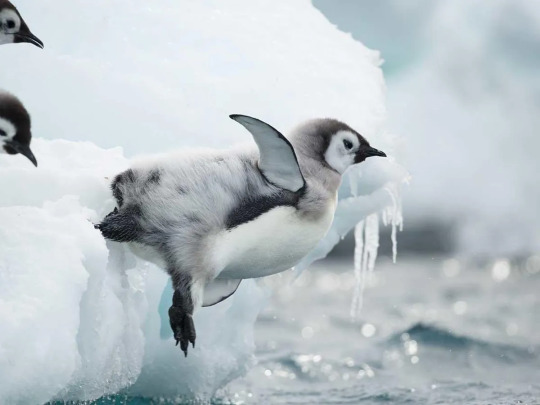
(image id: a newly-independent chick entering the water for the first time. It has not yet fully developed its adult plumage and has a mix of the chick's fluffy down and an adult's smoother coat. It is jumping off a ledge of ice into the water. Two other chicks watch from the side of the image. end id)
Emperor penguins are classified as near threatened by the IUCN, meaning they are losing population and may slip down into threatened status if conservation measures are not taken. The largest threat to emperor penguins is global warming reducing their habitat. Because they need sea ice to lay eggs and brood, the loss of sea ice every year has reduced the ability of the penguins to reproduce. in 2022, loss of sea ice led to a catastrophic failure to reproduce among nearly all known colonies. It is now estimated that 90% of colonies are at risk of dying out due to the loss of sea ice. If these trends are not reverted by reduction of global warming, the penguins could face extinction.

(Image id: two emperor penguins with their chick. The adults are standing behind the chick, which has its downy juvenile plumage. The chick stands about half the height of the parents. end id)
#wet beast wednesday#emperor penguin#penguin#marine biology#biology#zoology#ecology#animal facts#marine life#good parenting#cute#image description
116 notes
·
View notes
Text

72 notes
·
View notes
Text
Steve Irwin's Deleted Scene in Happy Feet HD.
(Nov 16, 2006.)
#happy feet#steve irwin#penguins#happy feet 2#cartoon#deleted scene#animation#emperor penguin#wandering albatross#blue whale#videos#nature#nostalgia#nostalgic
97 notes
·
View notes